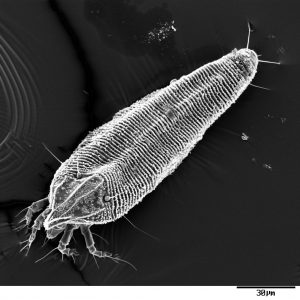Alicja Laska received Preludium grant from National Science Centre in Poland to study host specialization-generalization trade-offs in wheat curl mite Aceria tosichella. Congratulations! Project’s abstract
Our recent paper published in the Journal of Animal Ecology shows how birds avoid their sibling-species competitors.

Photo: Cezary Korkosz
We used data on abundance of two closely related passerine species, the Common Nightingale (Luscinia megarhynchos) and the Thrush Nightingale (Luscinia luscinia), collected across their syntopy, allotopy and allopatry. We found that interspecific competition gave marked imprints on patterns in habitat preferences of these two species. Whereas they preferred the same habitats in allopatry, their preferences became strikingly different in allotopy within sympatry where the abundance of the Common Nightingale increased towards dry and warm sites with low coverage of pastures, while the abundance of the Thrush Nightingale showed exactly opposite trends. It seems that both species “escape” from competition to allotopic sites covered by habitats avoided by the competitor. Therefore, we argue that the interspecific competition is an important driver of species’ distribution and habitat preference is variable across space and depends on the context created by biotic interactions.
The study was done in cooperation with the Charles University in Prague, Czech Republic. Bird data were collected by skilled volunteers within the Common Breeding Bird Survey in Poland.
More info:
Kamila Karpicka-Ignatowska and Ania Radwańska, BSc students in our Lab, have been awarded the Rector of Adam Mickiewicz University scholarships for outstanding students. Congratulations!
Agnieszka Majer was awarded the dr. Jan Kulczyk scholarship for scientific record! This scholarship is dedicated to outstanding PhD students and is highly competitive. Congratulations!
Agnieszka Majer was awarded the Rector of Adam Mickiewicz University scholarship for the scientific record in 2016. Congratulations!
For information about the research conducted by Agnieszka please visit this site: Dispersal strategies
Article written by Alicja Laska, Lechosław Kuczyński and Anna Skoracka from our team in collaboration with Brian Rector from GBRR, USDA-ARS, was published in the latest issue of Experimental and Applied Acarology.
In this study, we showed that protogyne females of two Abacarus species had a larger overall body size in winter than in either spring or summer. The results are consistent with our hypothesis that mites of these species, for which deutogyny has not been observed, undergo physiological changes such as accumulation of nutritional reserves, that enable them to withstand adverse environmental conditions.
The full article available here: http://link.springer.com/article/10.1007/s10493-017-0159-1
Our article about intraspecific social information use in wood warblers was selected by the Nordic Society journal editors to be included in the special virtual issue!
## LK
Recent Ecology paper co-authored by Jakub Szymkowiak from Pop Ecol Lab on system-specific roles of weather and pollination dynamics in driving seed production in European trees is now available online!
Using a 19-year data set from three sites in Poland, the authors investigated the relationship between weather, airborn pollen, and seed production in two oak species (Quercus petraea and Q. robur) and beech (Fagus sylvatica). They found that for oaks and beech, the warm summers preceding flowering correlated with high pollen abundance and warm springs resulted in high flowering synchrony (short pollen seasons). However, in beech the best predictor of seed crops was pollen abundance, while large seed crops in oaks correlated with short pollen seasons. These findings suggest that fundamentally different proximate mechanisms may drive masting in oaks and beech.
You can read the paper here and on ResearchGate. Read also what Jakub Szymkowiak wrote about this study on his page.
## JSz
Our recent article published in Scientific Reports is available online!
In this study, we investigated behavioral responses of two passively dispersing cereal-feeding eriophyoid mites: wheat curl mite (WCM, Aceria tosichella) and cereal rust mite (CRM, Abacarus hystrix) to potential dispersal cues. We found that wind was the most important cue influencing the mites’ behavior, what may facilitate long-distance dispersal and suggests high invasive potential. WCM significantly increased its ‘standing erect’ position when exposed to air currents. However, the proportion of potential dispersers was low, what may suggest that there are predisposed dispersers and residents in the population. WCM was generally more active than CRM which may be related to its high invasive potential.
The study was done in cooperation with the Department of Biological Sciences, University of Alberta, Canada and the Department of Applied Entomology, Warsaw University of Life Sciences.
The manuscript is part of Agnieszka Kiedrowicz’s PhD thesis. Congratulations!
The full article available here: https://www.nature.com/articles/s41598-017-04372-7
Jakub Szymkowiak was awarded the “START” scholarship by the Foundation for Polish Science! The scholarship is highly competitive and is dedicated to outstanding young researchers. Congratulations!
## LK
Address
Population Ecology Lab
Institute of Environmental Biology
Faculty of Biology
Adam Mickiewicz University in Poznań
Uniwersytetu Poznańskiego 6, 61-614 Poznań, Poland
Phone: +48 61 829-56-16
E-mail: popecol@amu.edu.pl
Archives
- January 2025
- May 2024
- September 2023
- July 2023
- June 2023
- May 2023
- April 2023
- February 2023
- April 2022
- March 2022
- January 2022
- October 2021
- September 2021
- June 2021
- May 2021
- April 2021
- March 2021
- December 2020
- September 2020
- August 2020
- May 2020
- March 2020
- December 2019
- November 2019
- August 2019
- May 2019
- January 2019
- November 2018
- October 2018
- September 2018
- August 2018
- July 2018
- June 2018
- May 2018
- March 2018
- December 2017
- November 2017
- September 2017
- August 2017
- July 2017
- June 2017
- May 2017
- February 2017
- January 2017
- December 2016
- September 2016






